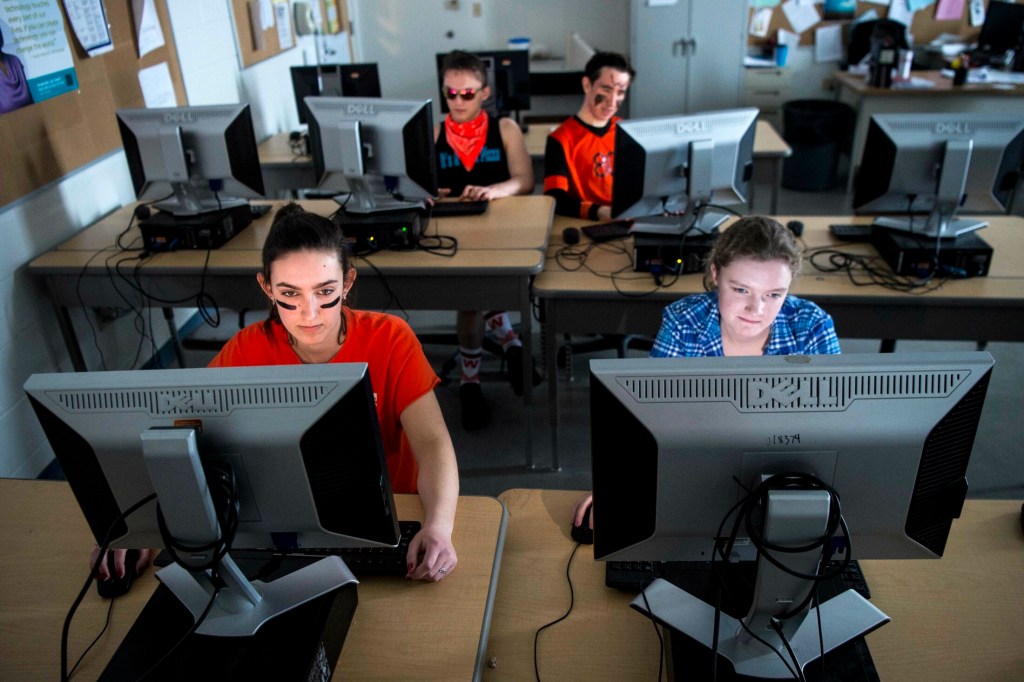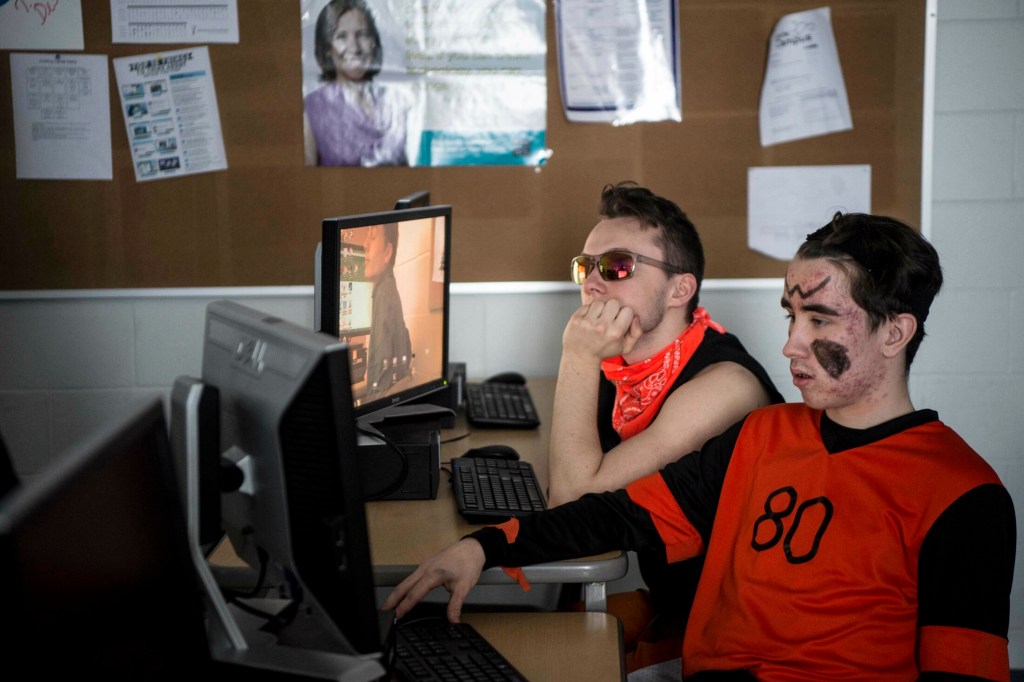WINSLOW — For those unfamiliar with computer science, “beauty” and “joy” are probably not the first words the subject brings to mind. But for students at Winslow High School, the case may soon be different.
Next year, the school will introduce a college-level class titled none other than the “Beauty and Joy of Computing.”
The yearlong course, open to sophomores through seniors, will prepare students to take the AP Computer Science Principles exam in May. It received unanimous approval from the Winslow school board at a meeting Monday night after passing the district’s curriculum committee.
As school board member John Ferry was quick to point out, the class’s name sounds unusual. It comes from University of California–Berkeley, where the curriculum was piloted in 2010 as a college course for non-computer science majors. The class was later adapted for use in the high school Advanced Placement program.
Lauren Mock, the program manager of Beauty and Joy of Computing at Berkeley, said 4,500 high school students across the country used the “BJC” curriculum as preparation for the AP Computer Science Principles exam in the 2017-18 school year. She was unsure how many of those students attended schools in Maine. According to Code.org, just 30 schools in the state currently offer an AP computer science course.
The course teaches the beginner-friendly drag-and-drop programming language Snap! alongside the “social implications of computers,” according to the syllabus. Students will use Snap! to create algorithms that can, for instance, simulate highway traffic or graph data to help identify trends. Topics of discussion range from big data and cybersecurity to how the internet is structured.
“It gives a better understanding of how computers work — it’s not just programming,” said Julie Houston, who teaches Winslow High School’s computer science classes. “But they do a lot of programming on Snap! that teaches them more about what really is going on out there in technology. It’s not just sitting down and writing a program that’s going to calculate how much change somebody has or something like that. And it stays up on technology. We’re constantly talking, having discussions through news articles about all the changes that are going on.”
While the new course is the first in the department with an AP designation, Winslow High School has included computer science in its curriculum for several years.
Currently, students can take Computer Applications, Computer-Aided Drafting (CAD), Multimedia Web Design and Computer Pre-Engineering as single-semester electives. The school also offers a yearlong Computer Programming course. Each student is required to take at least one semester-long computer course in order to graduate, though they can opt to take more as electives.
Houston said this semester is the first that she is teaching all five computer science courses the school offers at the same time.
“What they sign up for is what I teach,” she said. Class sizes range from 16 to 21 students.
While Houston said she was glad to see increased interest in computer courses this semester, she also noted that the classes have remained male-dominated. Only two out of 16 students enrolled in Computer Programming this year are girls, for instance.
“I’d like to push for more girls to be programmers because I enjoyed it back in college,” noted Houston, a University of Maine at Farmington graduate. “(The girls I teach now) are really good programmers. They do just as well as the boys do. But yes, there are far less girls in programming. They’re more likely to sign up for the (Computer Applications). Sometimes I do get girls in the CAD classes, but mostly boys.”
The demand for computer science is expanding. Computer and information technology jobs are projected to grow 13 percent faster than the average of all occupations in the country from 2016 to 2026, according to the U.S. Department of Labor Bureau of Labor Statistics.
In Maine, that equates to roughly 750 net jobs added in that time frame. Computer and information technology jobs in Maine had an annual mean wage of $79,031 in May 2017, while the mean annual wage for all occupations in Maine was $45,300 in May 2017, according to the Bureau of Labor Statistics’ Occupational Employment Statistics.
According to Code.org, if students learn computer science in high school, they are six times more likely to major in it in college. Women are 10 times more likely. Yet, just 23 percent of Maine students who took an AP Computer Science exam in 2018 were female.
Eleventh-grader Carrie Selwood, who is enrolled in Computer Programming, said she has found the course to be valuable. So far, she said, she has learned how to program with the computer languages Snap!, Alice and Python and will learn Java by the end of the year.
“I took it because I’m not sure what I want to do for my future yet, and programming is always a good step in the right direction,” she said. “Depending on what you want to do, all of these (languages) could be useful, especially in this day and age.”
Right now, the class is using code to create drawings and animations.
“It’s a completely different speed and topic than anything else in the school,” said senior Nick Tiner, who is also a Computer Programming student. “History, English and foreign languages are all kind of the same, standard stuff. But with computer stuff, it can apply to your possible major in college or — I don’t know — learning about how a computer itself works. It’s just more interesting. It’s completely different than anything else.”
Houston said she found out about the Beauty and Joy of Computing curriculum from Technology Director William Backman, who works with Waterville, Winslow and Vassalboro schools.
There are upwards of 15 other organizations that have created computer science curricula designed for high school use, but the Beauty and Joy of Computing is one of the only College Board-endorsed AP-level offerings that does not cost any money to implement. Even the textbook, “Blown to Bits,” is free as a digital copy online.
“They’re trying to push computer science so much that they’ll even just (cover the costs of a teacher attending) a training as long as they will just teach one computer science class,” Houston said. She attended a weeklong training on the Beauty and Joy of Computing curriculum in Fairfax, Virginia, last summer, which was paid for by Code.org and other national organizations.
Houston said she hopes Winslow’s new course, with its interdisciplinary focus, will attract students who might otherwise not be inclined to take a programming class — or even an AP course.
“I think that there’s some kids out there that probably this may be their only AP class,” she said.
Messalonskee High School is the only other area school that offers AP Computer Science Principles, which Nick Hart has taught there for about five years. Messalonskee High School Computer Science teacher Karen Kelley also teaches Web Design, which is a dual-enrollment course with Thomas College that enables students to earn both high school and college credits, similar to the Advanced Placement program.
Waterville Senior High School recently received an $881,000 grant from the Harold Alfond Foundation to develop a computer science program, though the one-credit course it is piloting in the fall will not have an AP designation.
“They’re pursuing this slightly different direction,” Backman said.
Waterville High School did not offer any computing classes this year, according to Backman. Students who want to get involved with coding in Waterville usually find extracurricular outlets instead.
“There are informal opportunities for computer programming, and that is often through the Lego robotics competition, which happens at the junior high level,” said Backman.
Maine has long been behind the curve in computer science education relative to the rest of the nation.
In 2017, the Legislature passed a bill to establish a task force to “develop an informed strategy to integrate computer science into the State’s proficiency-based high school diploma requirements, as well as to expose all students to computer science as a basic skill and as a potential career path.” The group issued a report in January 2018 outlining six recommendations for the state to consider implementing in order to address the problem.
Meg Robbins — 861-9239
mrobbins@centralmaine.com
Twitter: @megrobbins
Send questions/comments to the editors.






Success. Please wait for the page to reload. If the page does not reload within 5 seconds, please refresh the page.
Enter your email and password to access comments.
Hi, to comment on stories you must . This profile is in addition to your subscription and website login.
Already have a commenting profile? .
Invalid username/password.
Please check your email to confirm and complete your registration.
Only subscribers are eligible to post comments. Please subscribe or login first for digital access. Here’s why.
Use the form below to reset your password. When you've submitted your account email, we will send an email with a reset code.